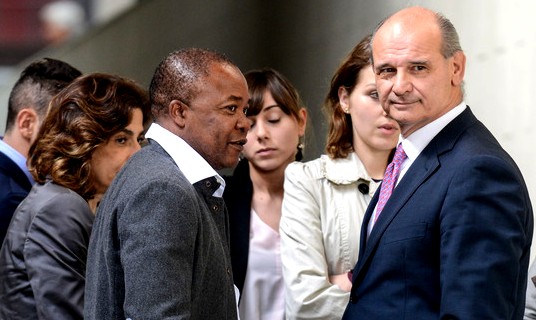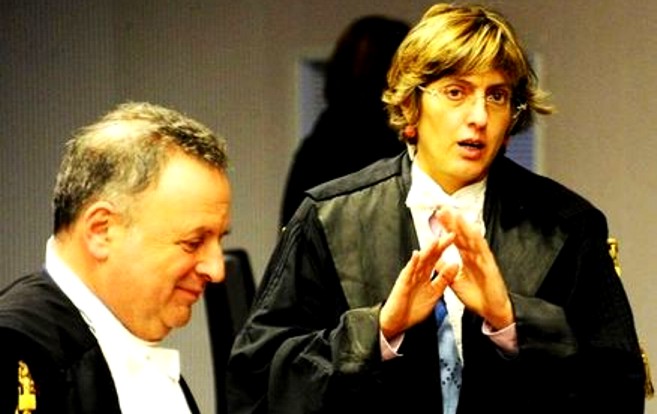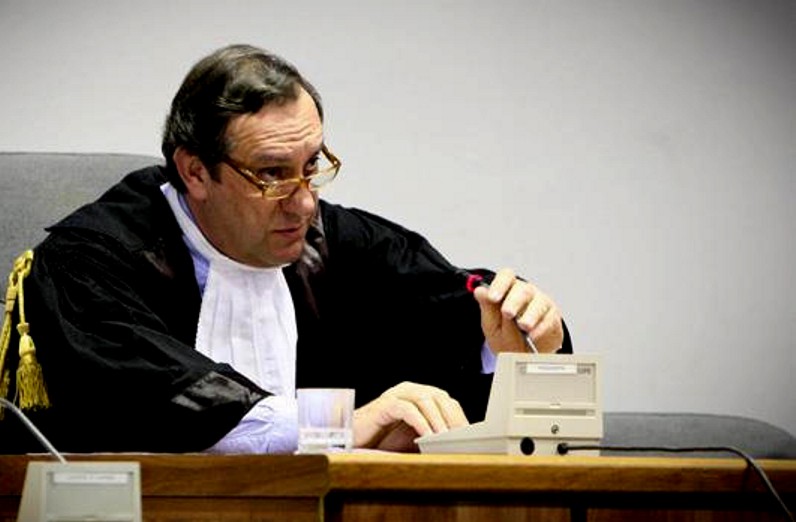
Category: The officially involved
Sunday, May 18, 2014
Knox Interrogation Hoax #4: More Hard Realities From Rita Ficcara, Nervousness From Defense
Posted by Our Main Posters
1. Overview of this hoax series
Knox turned up at the central police station unwanted late on 5-6 Nov 2007 and briefly helped police with a list of seven names. Her version of this has morphed into a gigantic hoax.
One highly consistent version of the brief chat was testified to by all those officials present, and accepted by all courts including the Italian Supreme Court. Knox has served three years in prison for it and the US Embassy saw nothing done wrong.
And then there is Knox’s endlessly shifting version, inflated opportunistically and erratically by herself and wannabee experts over nearly seven years now. Knox has done so in numerous interviews, in her 2013 book, on her website, in her email to Judge Nencini, and in her “appeal” to the European Court of Human Rights. And the PR shills have done so on websites, on TV, in books, and in attempts to lobby the US federal government.
This version was repudiated several times by her smart Italian lawyers (though not by her foolish American lawyers) and they did next to nothing to try to verify it when questioning those officials at trial.
See a longer summary in Post #1 here.
2. Continuing the cross-examination of Rita Ficarra
Below is the examination of Inspector Rita Ficarra by Carlo Pacelli, Patrick Lumumba’s lawyer. Very tough stuff. Chronologically, this preceded the defense cross-examinations in posts #2 and #3 and may well have dampened them.
Here “GCM” is Judge Massei. As the defenses fully acknowledged, this was merely a recap/summary, a simple checking of facts with someone who might be helpful which could have been done on a street corner. It was not a witness or suspect interrogation. Claims that it was are a key part of the great hoax.
This English translation of the relevant part of Rita Ficarra’s testimony on 28 February 2009 was by main poster and professional translator ZiaK. Her full translation will appear soon on the Meredith Case Wiki.
Please click here for more
Thursday, May 15, 2014
Knox Interrogation Hoax #3: Timid Defense Pussyfooting Toward Rita Ficcara, Key Witness
Posted by Our Main Posters
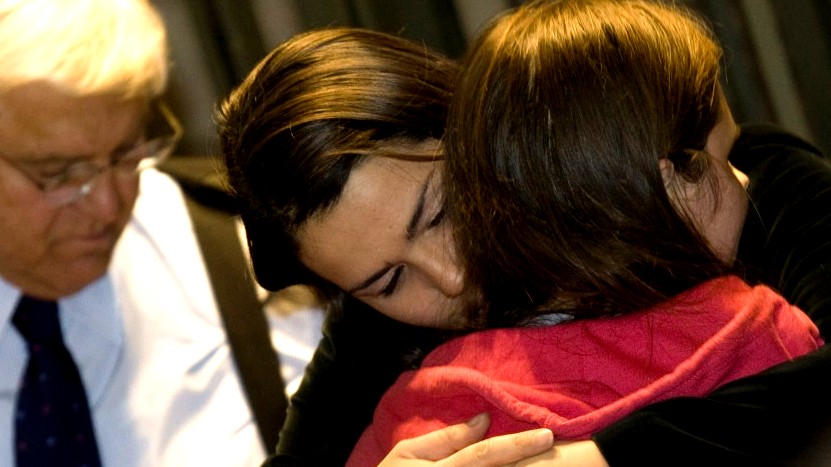
([Amanda Knox’s lawyers Luciano Ghirga and Maria Del Grasso who questioned Rita Ficarra]
1. Overview of this hoax series
Knox turned up at the central police station unwanted late on 5-6 Nov 2007 and briefly helped police with a list of seven names. Her version of this has morphed into a gigantic hoax.
One highly consistent version of the brief chat was testified to by all those officials present, and accepted by all courts including the Italian Supreme Court. Knox has served three years in prison for it and the US Embassy saw nothing done wrong.
And then there is Knox’s endlessly shifting version, inflated opportunistically and erratically by herself and wannabee experts over nearly seven years now. Knox has done so in numerous interviews, in her 2013 book, on her website, in her email to Judge Nencini, and in her “appeal” to the European Court of Human Rights. And the PR shills have done so on websites, on TV, in books, and in attempts to lobby the US federal government.
This version was repudiated several times by her smart Italian lawyers (though not by her foolish American lawyers) and they did next to nothing to try to verify it when questioning those officials at trial.
See a longer summary in Post #1 here.
2. Continuing the cross-examination of Rita Ficarra
In our hoax series second post we quoted two cross-examinations of Rita Ficarra by Sollecito’s lead lawyers. Here we quote two more, by two of Knox’s lawyers, Luciano Ghirga, and Maria Del Grasso.
Here “GCM” is Judge Massei. As the defenses fully acknowledged, this was merely a recap/summary, a simple checking of facts with someone who might be helpful which could have been done on a street corner. It was not a witness or suspect interrogation. Claims that it was are a key part of the great hoax.
This English translation of the relevant part of Rita Ficarra’s testimony on 28 February 2009 was by main poster and professional translator ZiaK. Her full translation will appear soon on the Meredith Case Wiki.
Please click here for more
Tuesday, May 13, 2014
Knox Interrogation Hoax #2: Trial Testimony From Rita Ficcara On Realities 5-6 Nov
Posted by Our Main Posters
1. Overview of this hoax series
Knox turned up at the central police station unwanted late on 5-6 Nov 2007 and briefly helped police with a list of seven names. Her version of this has morphed into a gigantic hoax.
One highly consistent version of the brief chat was testified to by all those officials present, and accepted by all courts including the Italian Supreme Court. Knox has served three years in prison for it and the US Embassy saw nothing done wrong.
And then there is Knox’s endlessly shifting version, inflated opportunistically and erratically by herself and wannabee experts over nearly seven years now. Knox has done so in numerous interviews, in her 2013 book, on her website, in her email to Judge Nencini, and in her “appeal” to the European Court of Human Rights. And the PR shills have done so on websites, on TV, in books, and in attempts to lobby the US federal government.
This version was repudiated several times by her smart Italian lawyers (though not by her foolish American lawyers) and they did next to nothing to try to verify it when questioning those officials at trial.
See a longer summary in Post #1 here.
2. The Testimony Of Inspector Rita Ficarra
Inspector Rita Ficarra was the one who initiated and led the discussion with Knox up to when Knox made her first statement, the first implicating Patrick Lumumba.
What follows is the cross-examination of Inspector Ficarra by the prosecution and all four cross-examining defense lawyers.
It would have been a really huge gain for the defenses at trial - a not-guilty verdict would have been almost guaranteed - if they had rattled Rita Ficarra and had her admit to Knox’s coercion. Especially by the supposed alternating tag teams. Especially of a Knox without food, drink, sleep, or breaks for the bathroom.
But note that in their cross-examinations NOT ONE defense lawyer even tried to go there. In their questioning of Rita Ficarra, that mundane scenario of the two brief sessions we describe above seems a given - their own sticking point.
Here “GCM” is Judge Massei. As the defenses fully acknowledged, this was merely a recap/summary, a simple checking of facts with someone who might be helpful which could have been done on a street corner. It was not a witness or suspect interrogation. Claims that it was are a key part of the great hoax.
This English translation of the relevant part of Rita Ficarra’s testimony on 28 February 2009 was by main poster and professional translator ZiaK. Her full translation will appear soon on the Meredith Case Wiki.
Please click here for more
Sunday, May 11, 2014
Knox Interrogation Hoax #1: Masterlist Of Posts Re Pre-Trial Events And Hoax Overview
Posted by Our Main Posters

Perugia Central Police Station at night (left-center)
1. Masterlist Of Posts In The Series
The Interrogation Hoax series will consist of a total of 24 posts.
These posts quote from a large number of transcripts only recently acquired and translated. There are no serious conflicts, no gray areas. One can assume with total certainty that this is the real thing (see Part 3 below), and that any other versions (see Part 4 below) are fabricated.
Numbering of posts 1-24 is not chronological, it represents the original order of postings.
1. What Happened At AK & RS Q&A Prior To 6 Nov
Click for Post: #19: ALL Knox Q&A Sessions 2-6 November 2007 WERE Recorded #1
Click for Post: #20: ALL Knox Q&A Sessions 2-6 November 2007 WERE Recorded #2
2. What Happened At Knox Q&A 6 Nov Ending 1:45 AM
Click for Post: #2: Trial Testimony From Rita Ficcara On Realities 5-6 Nov
Click for Post: #3: More Defense Pussyfooting Toward Rita Ficcara, Key Witness
Click for Post: #4: More Hard Realities From Rita Ficcara, More Nervousness From Defense
Click for Post: #12: Ficarra & Knox Notes PROVE Knox Merely Worked On Visitors Names List
Click for Post: #5: Key Witness Monica Napoleoni Confirms Knox Self-Imploded 5-6 Nov
Click for Post: #7: Testimony Of Witness Lorena Zugarini On The Knox Conniption 5-6 Nov
Click for Post: #8: Testimony Of Interpreter Donnino On Events Night Of 5 November
3. What Happened At Sollecito Q&A 6 Nov Ending 3:30 AM
Click for Post: #6: Sollecito Transcript & Actions Further Damage Knox Version
Click for Post: #9: Officer Moscatelli’s Recap/Summary Session With Sollecito 5-6 Nov
4. What Happened At Knox-Rights Session Ending 5:45am
Click for Post: #15: Knox Is Told Her Rights And Repeats Fake Murder Charge
5. What Of Relevance Happened In Ensuing Months
Click for Post: #13: The First Two Pre-Trial Opportunities Which Knox Flunked
Click for Post: #14: The Third Pre-Trial Opportunitty Which Knox Flunked
Click for Post: #16: The Fourth Pre-Trial Opportunity Which Knox Flunked
Click for Post: #17: Sollecito April 2008 Before Supreme Court Again Coldshoulders Knox
Click for Post:#18: The Final Pre-Trial Opportunities Which Knox Flunked
Click for Post: #21: Illustrating How Batshit Crazy The Interrogation Hoax Has Become
6. Why Investigators’ Version Won Hands-Down At Trial
Click for Post: #10: Why Prosecution And Defenses Never Believed Knox’s Version #1
Click for Post: #11: Why Prosecution And Defenses Never Believed Knox’s Version #2
2. Explaining Overall Arc Of Events
Much of the testimony listed above was about events at the central police station pre-arrest in early November 2007 and subsequent court attempts to achieve some believability and relief.
Early in 2009 at trial Knox and Sollecito sat glumly through all of the investigators’ pre-arrest testimony and cross-examination at trial. They were downhearted and apprehensive, and there were no smiles and few interruptions.
Subsequently Sollecito chose not to get on the stand, so from his team there really was never a rebuttal.
But Knox HAD to get on the stand, in July, for two days. She had no other way to defend herself against the serious felony crime of falsely framing Patrick for murder.
It was her word against theirs. It contradicted in many places what she had heard months earlier in sworn testimony from many investigators.
Knox’s version inevitably weakened a lot under cross-examination, and was ultimately a fail at trial and several appeals, even the annulled one.
Knox ended up serving three years. While on the stand she confirmed that she had been treated well, stiffing thousands of supporters duped into believing she had not been.
3. Explaining Court-Accepted Narrative For 6 Nov
This is an overview of Knox’s so-called “interrogation” at Perugia’s central police station, the subject of the first ten posts.
It led to her arrest and three years served. To make this picture really firm we will quote a lot of the testimony at trial. The Case Wiki carries all of these transcripts, many in English translation, and more.
Senior Inspector Rita Ficarra testified that she arrived back at the police station late on 5 November, and finds her way blocked by a cartwheeling Knox.
She rebukes Knox, who testily responds that she is tired of the investigation. Rita Ficarra tells Knox to go home and get some sleep. Knox testily refuses, and remains there.
Shortly after, Ficarra suggests to Knox that if she really wants to help, she could add to the list of possible perps - men who Meredith knew and who might have visited the house.
This was a recap/summary, a simple checking of facts with someone who might or might not be of help. This could have been done on a street corner or in a house by a single officer. It was not a witness or suspect interrogation. From the transcript:
Ghirga: “While this interrogation - let’s call it thus - was in progress, some colleagues arrive…” Ficarra: “It was not an interrogation, Attorney.” Ghirga: “They are called recaps/summaries.
Knox eagerly agrees. So they begin on the list.
This goes slowly because of language problems, until an interpreter, Anna Donnino, arrives. In total only Knox and four others (three of them women) are present.
Knox builds a list of seven people and adds maps and phone numbers (placed in evidence) in a calm proceeding. These were the names: Peter Svizzero, Patrick, Ardak, Juve, Spiros, Shaki and “a South African [Guede]” who played basketball near the house.
At several points in the evening Knox is provided with refreshments. No voices are ever raised, no bathroom breaks are refused.
In a separate wing Inspector Napoleoni and a couple of colleagues are seeking facts from Sollecito. Shown conflicts between what he has said and what his phone records show, Sollecito backtracks, and declares that Knox went out alone on the night, and made him lie.
Napoleoni moves through the questura to suggest to Ficarra to discuss the night of the attack with Knox in more detail and clarify who might have been present. Knox is not informed of Sollecito’s backtrack. She is asked for more names and spontaneously shares her phone. There is an outgoing to Patrick but no prior incoming. Knox is asked who Patrick is.
Suddenly, to the considerable surprise of others present, Knox has a yelling, head-clutching conniption (the first of several that night) and says “It’s him, it’s him, it was him, he killed her”. The session is halted.
Despite warnings she should not do so without a lawyer, Knox insists on a recorded statement which says she headed out to meet Patrick that night after he texted her. She accuses Patrick of killing Meredith.
Efforts are made throughout the next several hours to try to help Knox to calm down. Knox is put on hold, given more refreshments, and made comfortable on some chairs so she might try to get some sleep.
A second session ending at 5:45 is intended as merely a formal reading of Knox’s legal status and her right to a lawyer, with Dr Mignini presiding. She is to be held as a material witness and for her own protection.
Again warned that she should not speak without a lawyer, and no questions can be asked, Knox still insists on a second spontaneous accusation culminating in a second recorded statement.
This also says she went out to meet Patrick that night, also accuses Patrick of killing Meredith, and now also hints that Sollecito may have been there.
Just before noon, now under arrest and about to be taken to Capanne Prison, Knox insists on writing out at length a third statement this time in English.
She gleefully hands it to Rita Ficcara who cannot read it as she as no English. In the statement, Knox included this damning remark, without any mention of having been coerced: “The questions that need answering, at least for how I’m thinking are… 2. Why did I think of Patrik?”
Knox’s lawyers never ever substantially challenge this version, and never lodge any complaint. At trial in 2009 they accept on the record that there was no interrogation, and leave standing that Knox insisted on all three statements, and dont ever pursue Knox’s claims that she was coerced.
Courts all noted that there is no mention in that third note of Knox having been coerced, although this note was her idea and she could put in it anything she liked. From this there never was any going back.
In July 2009 at trial, in face of days and days of prior investigator testimony, Knox brashly tried to substitute this scenario above with the one below. Of course she was disbelieved.
For the calunnia framing of Patrick Lumumba Judge Massei in 2009 sentenced her to a year more than Sollecito, amended by Judge Hellmann in 2011 to three years served.
The Supreme Court definitively overruled her calunnia appeal so for her false framing of Patrick she is a felon for life.
4. Explaining Knox Family & PR Alternative
Knox’s Italian lawyers were not a part of this; in contrast the American PR lawyer Ted Simon sought to introduce major confusion.
In Italy, lawyers are REQUIRED to report tales of abuse of their clients or face possible criminal charges. Contrariwise, if they knowingly report false charges they can face similar charges. So what they do is a strong indicator of truth.
Amanda Knox’s lawyers not only did not ever report any abuse. They even announced publicly, in face of incessant claims of abuse by Knox, family, and PR forces, that they had seen no evidence of abuse and so would not be reporting.
Though her precise claims vary and often contradict one another, Knox herself has on and off ever since November 2007 tried to put the investigators on trial - tried to blame the police for causing her conniption and her false accusation of Patrick for the death of Meredith.
Her fail rate has been spectacular.
Knox failed to convince (1) Supervising Magistrate Matteini and (2) the Ricciarelli review panel in November 2007, (3) failed to convince Prosecutor Mignini in December 2007, (4) failed to convince the Supreme Court in April 2008, (5) failed to convince the Micheli court in late 2008, (6) failed to convince the judges and jury at trial 2009, (7) failed at annulled appeal 2011, (8) failed at repeat appeal 2013, (9) failed to convince the Supreme Court in 2012 and (10) failed again in 2015.
As Knox’s team simply did not ever believe her, they may not have given this their hardest shot. It was not part of their largely spurious complaint to the EC HR.
And yet despite all of these failures, the huge and very nasty Knox PR effort went full-bore ahead with the abuse allegations anyway.
Read this post of 11 February 2009 which was about two weeks before the Knox “interrogators” were cross-examined at trial, and several months before Knox herself took the stand. Dozens of media reports repeated the Knox claims as if true.
Knox repeated them in her April 2013 book, and her December 2013 email to Judge Nencini, and her appeal to EHCR Strasbourg, and in some TV and newspaper interviews, including one with the Italian weekly Oggi which caused that paper legal harm.
This version has been blown up by Knox PR shills in internet posts, articles, TV interviews, and books. Among others propagating it have been Raffaele Sollecito (in his book), Doug Preston, Saul Kassin, Steve Moore (especially), John Douglas, Jim Clemente, Paul Ciolino, Michael Heavey, Greg Hampikian, Chris Halkidis, Mark Waterbury, Doug Bremner, Candace Dempsey, Nina Burleigh, Bruce Fischer, and many posters on the Knox sites and Fischer sites and on Ground Report.
Main claims included 50-plus hours of “interrogation”, numerous officers in teams, no food or drink, no sleep, no bathroom breaks, no lawyer, no recording, and much abuse and yelling and suggestions and threats. Way beyond anything even Knox herself and notably her own lawyers ever claimed.
- Here is Steve Moore claiming that around a dozen cops in rotating tag teams of two assaulted a starving and sleepless Knox over 20/30/40 hours, threatened her, and refused her a lawyer throughout.
- Here is Saul Kassin claiming that Knox was interrogated over the entire night of 5-6 November, until she was finally broken and a coerced “confession” emerged - even though the “false confession” actually framed Patrick and was in reality a false accusation. That Kassin ignores.
- Here are several former FBI profilers blatantly embellishing the same claims in a book, with (today) 60 five-star reviews.
And yet Knox’s own Italian lawyers specifically denied her accusations! No complaint against the police was ever lodged. All courts disbelieved her. Knox served her three years. But still the PR-driven hoax keeps resounding.
Tuesday, May 06, 2014
Judge Nencini Issues Harsh Warning To Tell The Truth - So Amanda Knox Does The Precise Opposite
Posted by Our Main Posters
1. Substance Of The Nencini Explanatory Report
The Florence Court of Appeals released the Nencini Motivations Report in Florence one week ago today.
This report explains the rejection of Knox’s and Sollecito’s own first appeal against the Massei trial outcome of 2009. Four years were lost because the Hellmann court, which heard the first iteration of that appeal was bent as Cassation, the competent judge displaced, and now Judge Nencini have all concluded.
The Hellmann outcome of 2011 was mostly annulled, as in “ceased to exist”. The main findings and verdict have zero legal standing, and zero relevance to today’s process though (see below) Knox and Sollecito repeatedly try to ride that dead horse again.
Cassation confirmed Knox’s three-year prison sentence for framing Patrick (for which she has served the time). And Cassation referred the methods and recommendations of the Conti & Vecchiotti consultancy, which Cassation had hammered on legal grounds, to the Florence appeal court for the substance to be reviewed.
Our evidence and law experts here and in Italy have been looking at Judge Nencini’s 347 page report and find it hard-hitting and unequivocally blunt.
It will be extremely hard to appeal against within the very narrow limits Cassation allows. It removes all of Judge Massei’s ambiguities about motives, it reaffirms the witness statements of Curatolo and Quintavalle, and it judicially affirms the validity of the DNA and other forensic evidence against Knox and Sollecito.
There is overwhelming proof of the presence of all three perps, Knox, Sollecito and Guede, in the cottage that night. Guede is considered to have been brought inside by Knox, who had the only key, and he could not possibly have broken in through Filomena Romanelli’s window in the manner asserted by their defense.
Especially troubling for the defense, the report hints at an illegal suborning of the independent forensic experts appointed by the Hellmann court, and it also hints that the two “supergrass” witnesses, the prisoners Aviello and Alessi, may have been illegally tampered with by Sollecito’s lawyer Giulia Bongiorno, as first claimed 30 months ago.
The report warns that criminal slander of justice officials and other contempts of court will be heavily leaned on.
So the report demolishes the last remnants of Judge Claudio Hellmann’s now annulled acquittal, and substitutes for its fatally flawed reasoning a tightly crafted report that confirms the convictions of Knox and Sollecito.
It confirms that they acted in concert with Guede as Cassation itself long ago concluded had to be the case, and it appears to close any possible argument against the verdict that will carry weight at the Supreme Court.
2. Amanda Knox’s Press-Release Statement In Response
Knox issued a seven paragraph statement later the same day. Maybe not the smartest bit of work.
It is riddled with factual inaccuracies and innuendo, is typically arrogant and condescending in tone, includes the trademark racial innuendos about Italians and the black guy in the case, and shows no signs in its compiling of competent legal help.
Here below we show the various ways in which Knox flouts Judge Nencini’s warning and attempts to mislead. None of what Knox stated was the truth.
Claim: The Hellmann Court Found Knox “Innocent”
I have stated from the beginning of this long ordeal that I am innocent of the accusations against me. I was found innocent by the only court in Italy that retained independent forensic experts to review my case. I want to state again today what I have said throughout this process: I am innocent of the accusation against me, and the recent motivation document does not ““ and cannot ““ change the fact of my innocence.
First even if she was provisionally released following the now-annulled appeal, Amanda Knox was never, repeat never, found innocent. Only Cassation can make that final ruling, and they strongly found against the lower court that had jumped the tracks midway-through.
Even Judge Hellman himself said after his verdict that ‘the truth might be otherwise’ and suggested any reasonable doubt as to guilt has not been categorically and legally dismissed. He seemed to divine that he had failed in his task of bending the outcome in a way that would stay bent.
Second the court that Knox thinks found her innocent no longer exists as a legal fact. It seems to endemically escape Knox that the Hellmann outcome was annulled. Annulled. As in: wiped off the books. It is surprising that even Curt Knox and Ted Simon and David Marriott, while admittedly themselves no masters of Italian law, cannot help Knox to grasp that simple fact. It weakens her to keep clinging to a myth.
One reason it was annulled (and the reasons were overwhelming, one of Italy’s most decisive annullments ever) was that both Cassation and Dr Nencini had good reason to suspect the Hellmann court had been corrupted and had deliberately departed from the evidence and the law. Knox needs to ask herself why the highly qualified Judge Chiari was pushed aside (and immediately resigned in anger) in favor of a wrongly-qualified business judge (who is now ignominiously retired).
Third, it needs to be grasped by Knox that the Conti/Vecchiotti consultancy, far from being legally right and acting independently (and scientifically), was suggested as illegal by Perugia’s chief prosecutor Dr Galati, as appeal judges are forbidden from appointing consultants at that stage. While Cassation passed in ruling on that one, the consultancy outcome was criticised as illogical and legally unsound by both Cassation and Judge Nencini, as biased, full of baseless innuendo about contamination, and possibly tampered with by an American academic hired by the defense.
Conclusion: none of what Knox stated was the truth.
Claim: Only Rudy Guede’s DNA Was Found
The recent motivation document does not ““ and cannot ““ change the forensic evidence: experts agreed that my DNA was not found anywhere in Meredith’s room, while the DNA of the actual murderer, Rudy Guede, was found throughout that room and on Meredith’s body. This forensic evidence directly refutes the multiple-assailant theory found in the new motivation document. This theory is not supported by any reliable forensic evidence.
The forensic evidence is not just the DNA on the knife or in the room. It also includes the extensive traces deposited by Knox in the rest of the crime scene (bathroom, corridor and Filomena’s bedroom), and it also includes all of the autopsy.
Meredith’s room itself was not comprehensively tested for DNA. The room was dusted only for fingerprints, as the investigators had to make a call on prints or DNA.
Guede’s DNA was not found “throughout that room” or all over Meredith’s body. Guede’s DNA was found only in one instance on Meredith’s body, on a part of Meredith’s bra, mixed with Meredith’s blood on a sweatshirt cuff and the purse, and on toilet paper in a bathroom.
Knox’s DNA was found mixed with the blood of Meredith in multiple places, the only known source for which was the pool of blood in Meredith’s bedroom: multiple prints of Knox’s bare right foot in the hallway and in Knox’ bedroom, and at least five instances of mixed samples containing the DNA of both Meredith and Knox, including in the north bathroom and Filomena’s room, places where Guede did not go.
The court ruled that the blood and mixed DNA evidence found throughout the crime scene places her and Sollecito there at the time of the murder at the same time as Rudy Guede.
Though not DNA, there was one bloody shoe print in Meredith’s bedroom estimated to be Euro size 36-38, compatible with Knox size 37 and with no one else known of who could have left it there.
No fingerprints of anyone were found in the room, just a palmprint of Rudy Guede. Fingerprints were not found even on Knox’s own lamp, which she only confirmed grudgingly at trial was her own, and not found even in Knox’s own bedroom. Overwhelming sign of a cleanup? The courts all believed so.
Conclusion: none of what Knox stated was the truth.
Claim: The Knife As Murder Weapon Was Disproved
The forensic evidence also directly refutes the theory that the kitchen knife was the murder weapon: the court-appointed independent experts confirmed that neither Meredith’s blood nor her DNA was on the alleged murder weapon, which experts also agreed did not match the stab wounds or the bloody imprint of a knife on her pillow.
Judge Nencini’s finding is that two knives HAD to have been involved from both side of Meredith’s throat and the final blow was by a large knife the same size as the one in evidence.
Regarding the large knife, Knox rehashes the same arguments her defense made to no avail before the original trial court that found her guilty. We posted explaining the solid proof here and here.
The only DNA tests that matter with regard to the big knife are (1) the sound finding by Dr Stefanoni that Meredith’s DNA was on the blade - Knox is wrong, the independent experts did not refute that; (2) the sound findings by Dr Stefanoni and the Carabinieri lab that Knox’s DNA was on both the blade and the handle of the knife. None were overturned; contamination was ruled out; and the defense was left without a shot.
The Hellmann-appointed experts confirmed that the genetic profile found on the knife blade was the genetic profile of Meredith Kercher. The TMB test did not confirm if it was blood, but defense experts were forced to concede that TMB erroneously fails to confirm that blood is present about half the times in assessing minute quantities.
The Hellmann-appointed experts tried to explain away the genetic profile as being the result of contamination, but were never able to identify any scenario by which a knife that had supposedly never left Sollecto’s kitchen contained biological material yielding a clear genetic profile of Meredith Kercher.
Accordingly the Appeals court has ruled the kitchen knife is in fact the one that was wielded by her to strike a final blow, and at the same time there was a second knife in the room used by Sollecito to torture Meredith.
London DNA expert Dr David Balding certified Raf’s DNA as being on the bra clasp. This proves by itself that Sollecito was there. Knox belatedly claimed she stayed at the Via Garibaldi apartment with Sollecito all evening and now and then Sollecito belatedly backs her up. But how could that be if the court has positives of his footprint on the bathroom rug and on the bra, showing he was over at Meredith’s cottage that night? Proof of him present equals proof of her.
The Hellmann-appointed experts were not charged with analyzing the stab wounds, or whether the imprint on a sheet was of a knife or of something else and the result of the fabric being folded - nor was this within their field of expertise. Defense experts testifying on these issues were in conflict.
Conclusion: none of what Knox stated was the truth.
Claim: The Circumstantial Evidence Is “Unreliable”
In fact, in the prior proceeding in which I was found innocent, the court specifically concluded that the forensic evidence did not support my alleged participation in the crime and further found that the circumstantial evidence was both unreliable and contrary to a conclusion of guilt.
The recent motivation document does not ““ and cannot ““ change the fact that the forensic evidence still does not support my participation and the circumstantial evidence still remains unreliable and contrary to the conclusion of guilt.
Knox appeals to Hellmann’s ruling on the circumstantial evidence being unsound. But the Supreme Court, in annulling Hellmann, explained why it found his arguments illogical, and reminded the court of the standards by which circumstantial evidence must form a coherent whole. Judge Nencini in our opinion amply meets those standards in an elegantly argued report which will be hard to defeat at Rome’s Supreme Court.
Knox herself has proved the “unreliable” one, proven over and over again to be a liar who attests to her own bad memory in written statements, who talks of “dreams her mind made up”, who repeatedly goes vague.
We cannot rely on Knox’s recall of phoning mom, the timing of which moves and sometimes disappears. Knox claims she can’t remember where she was that night, she told a whopper of a lie on her boss, she can’t remember if the door to Filomena’s room was open or closed, she can’t remember her own lamp, she claims she rarely looks at a clock. On and on.
The strongest example of circumstantial evidence Knox can’t shake is the five spots of her DNA mixed with Meredith’s blood. Maybe 2 or 3 spots could be put down to unlucky chance, but five really removes reasonable doubt.
Conclusion: none of what Knox stated was the truth.
Claim: No “Legitimate” Motive Is Identified
And the recent motivation document does not ““ and cannot ““ identify any legitimate motive for my alleged involvement in this terrible crime. No fewer than three motives have been previously advanced by the prosecution and by the courts. Each of these theories was as unsupported as the purported motive found in the new motivation document, and each of these alleged motives was subsequently abandoned by the prosecution or the courts. Like the prior “motives”, the latest “motive” in the new motivation document is not supported by any credible evidence or logic. There is simply no basis in the record or otherwise for this latest theory.
“Proof” of motive is not required in any legal system in the world. The serial misleader Ted Simon should at least admit to that. The motives advanced were not withdrawn or abandoned by successive judges; they were fine-tuned chronologically only within very narrow limits. The sex hazing that went too far was weighted downward and pushed back, and a battle over theft of money was weighted upward and pushed forward.
The court found very compelling evidence that Knox committed the murder and led the pack. It postulates that Meredith and Amanda were incompatible with each other, and that Knox, Sollecito and Guede, high on drugs, first assaulted Meredith, restrained and abused her, and then murdered her with two knives.
Knox was known to be in serious rejection by those she encountered in Perugia for her sharp-elbowed brashness - growing rejection by her flatmates, her employer and the bar customers, and just about everyone she encountered except initially for Sollecito. But soon even he was being given a hard time and has semi-rejected Knox in return ever since. The first words of his 8 November 2007 statement to Judge Matteini were “I wish to not see Amanda ever again.”
And money was a huge looming problem which could have had her back in Seattle in weeks. Knox was known to want to head for China, and was known locally to have an expensive drug habit which had cut her savings in half. She really needed to hang on to that job at Patrick’s bar, especially as she had no work permit.
Sollecito’s bank balance was minimally topped up by his father each month. Francesco seemed to realise cocaine is an expensive habit and didnt want to see his son off down that slippery slope. So with Knox’s own habit, her remaining savings would have run out in weeks. How then to explain to Curt Knox that she really needed a whole lot more? He would have given her a very hard time before any more money flowed.
Conclusion: none of what Knox stated was the truth.
Claim: The Supreme Court Will Allow Another Full Appeal
I will now focus on pursuing an appeal before the Italian supreme court. I remain hopeful that the Italian courts will once again recognise my innocence. I want to thank once again, from the bottom of my heart, all of those””family, friends, and strangers””who have supported me and believe in my innocence.
Cassation wont “once again” recognise innocence. Knox should be encouraged to get real. So should her dummy followers - all her immediate circle know she was involved. There are no obvious grounds for Cassation to second-guess Judge Nencini, a very senior and very respected judge, considering the thoroughness of the Nencini Report. The disjointed series of statements on her blog arguing to the contrary look like the opinions of her friends and fans, not legal minds, and it is time she realizes they have feet of sand and no power to help.
Conclusion: none of what Knox stated was the truth.
Three lawyers and five others supplied the rebuttals for Amanda Knox’s false claims here and elsewhere, such as Knox’s email to Judge Nencini and her interviews on TV. Posts on those follow soon. Below: the careful way in which Italian media explain what Judge Nencini released.
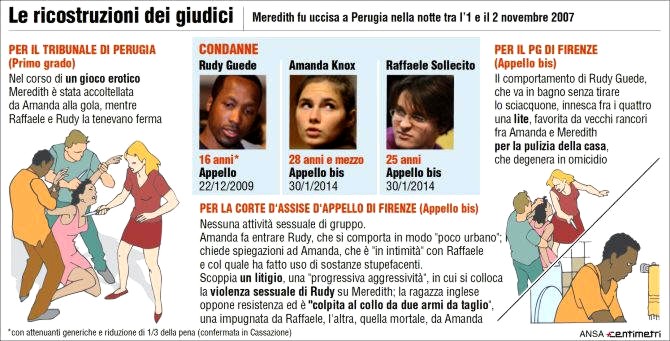
Sunday, April 27, 2014
Knox & Sollecito Actions In The Week Prior To Arrest: An Incriminating Behavior Pattern For Sure
Posted by James Raper
[Video above: Sollecito slams Knox’s weird behavior, while not explaining numerous examples of his own ]
1. Today’s Context To This Post
A very strong case for guilt has been made at trial and endorsed at the first-level appeal.
This series hammers home the growing hundreds of incriminating stark differences between the official evidence record, Sollecito’s and Knox’s two books, and Sollecito’s and Knox’s multiple conflicting claims since.
The focus of this post as with the one immediately below is upon the described behaviours of Knox and Sollecito, from the very beginning to this very day. This pattern has more than contributed to the certainty of their involvement in the murder of Meredith Kercher.
2. How The Behavior Speaks To Guilt
The early pointer of the staged break-in aside this behaviour gave investigators an insight into the pair’s possible involvement back on Day One: Behavioral pointers have continued on a par with corroborated developments in the case.
It has even continued, incredibly, since their release from prison. For me it is the thread that runs through this case having as much to do with the overall picture of culpability as the other elements .
This behaviour - to include what they have to say for themselves - is a catalogue of the inappropriate, of the implausible, of inconsistencies and contradictions, of evasions and obfuscations, to be gleaned from the accounts of Knox and Sollecito themselves and highlighted in the accounts of other witnesses. It is also to be gleaned from phone and computer records.
Taken together it is a formidable body of evidence which goes to character and culpability. It cannot be attributed to a railroading job, the machinations of a corrupt and evil prosecutor or character assassination by the media. It is also implausible if not impossible to explain it as being due to naivety, confusion or some quirkiness of character.
It amounts to the pair of them concocting stories, telling lies and misleading investigators and the general public.
3. Physical Evidence Array Is Already Substantial
There are numerous items of evidence which are building blocks in the prosecution case and with which we are all familiar.
- 1. The staged break-in via Filomena’s window with pointers to this outside, on the windows and shutters, and throughout the bedroom.
2. The evident partial clean up proved by footprint trails with footprints missing and what was behind the locked door.
3. Amanda Knox’s lamp on the floor behind Meredith’s locked door which she only conceded was her own at trial, under pressure.
4. Knox’s dried and congealed blood on the tap in the small bathroom that Amanda Knox and Meredith shared.
5. The bloody footprint on the mat in that bathroom definitively attributed to Sollecito rather than Guede
6. The mixed DNA of Knox and Meredith Kercher found in blood in the basin, the bidet and on the box of Q tips in that bathroom
7. Two luminol enhanced mixed traces containing DNA belonging to Knox and Meredith Kercher, one in the corridor and the other in Filomena’s room
8. Two luminol enhanced footprints of Knox in the corridor and one of Sollecito immediately outside Meredith’s room.
9. The knife taken from Sollecito’s apartment with Meredith Kercher’s DNA on the blade and Knox’s DNA on the handle and on the blade
10. Meredith Kercher’s bra clasp with Sollecito’s DNA on a hook and contamination possibilities definitively ruled out.
4. Behaviors In The First Week Of November 2007
I don’t want to make this an unduly long post. Accordingly I am going to concentrate on the period up to that famous police interrogation analysed just below. As to that critical period I will be selective but it should be enough.
The Lady With The Mop?
The story (in Knox’s e-mail) that she had visited the cottage to collect a mop, have a shower and get a change of clothing, earlier on the morning of the 2nd November, but did not notice that Filomena’s window had been broken and her room trashed is just that - a made up story. It is entirely implausible and the account unreliable for a number of reasons including-
- (a) it is hard to believe that she did not notice the hard to miss fact that the shutters to Filomena’s window were (as they were found) open - this would have alerted her to the likelihood that Filomena was back home which she would, of course, have checked out of curiosity if nothing else given that she found no one home.
(b) her claim that Filomena’s door was shut is contradicted by Sollecito who wrote (prison diary) that when he later entered the cottage with Knox Filomena’s door was wide open.
(c) it is hard to believe that she took a shower without noticing until after her shower (as she claimed) that there was blood on the bathroom mat, including a bloody footprint. In fact she didn’t even claim to notice that it was a footprint despite the fact that it was obviously so.
(d) it is hard to believe that having found the front door wide open and having found blood, and having opted for a shower and to blow dry her hair, she never got round to checking for any sign of Meredith’s presence. Any one else would have tried her door to check whether or not she was home.
(e) from her appearance at the cottage that morning it is hard to believe that she took a shower at all (let alone blow dried her hair) and the cops remarked that she reeked of body odour.
(f) less problematic but nevertheless still somewhat surprising is that as she is drying her hair she makes a fuss over shit (left by Guede) in the toilet, describes herself as being “uncomfortable” about it but does not flush it away before grabbing the mop and leaving.
The Two Stayed At Home?
The story that Knox and Sollecito had spent the previous night (the night of Meredith’s murder) indoors, critically from 9 pm onwards, that both had slept and that Knox had been the first to rise at about 10.30 am the next morning is implausible and uncorroborated, not only because this alibi is directly contradicted by the testimony of Curatolo and Quintavalle, and Sollecito’s statement to the police that Knox had gone out and not returned until about 1 am, but also in view of the following facts.
- (a) Curatolo claimed to have first seen the Knox and Sollecito in Piazza Grimana shortly after 9.30 pm but Knox claimed in her trial testimony that she and Raffaele had cooked and eaten a meal between 9.30 and 10 pm.
GCM: Can you say what time this was?
AK: umm, around, umm, we ate around 9.30 or 10, and then after we had eaten, and he was washing the dishes, well, as I said, I don’t look at the clock much, but it was around 10. And”¦he”¦umm”¦well, he was washing the dishes and, umm, the water was coming out and he was very bummed, displeased, he told me he had just had that thing repaired. He was annoyed that it had broken again. So”¦umm
LG: Yes, so you talked a bit. Then what did you do?
AK: Then we smoked a joint together”¦”¦we made love”¦..then we fell asleep.
Unfortunately Sollecito’s father himself torpedoed this dodge by telling the court that when he phoned his son at 8.42 pm Sollecito had told him that there had been a water leak while he was washing the dishes. Taking into account Knox’s testimony that they had eaten before the dish washing, this places the meal and dish washing before that call.
(b) Sollecito told the police that at about 11 pm he had received a call from his father on his land line. Not only is that not confirmed by his father but there is no log of such a call.
(c) There is no log of a call to his mobile at that time either though his father had sent a text message at that time but which Sollecito did not receive until 6. 03 am the following morning. We know that he had received it at that time because that is the time at which it is logged in the phone records. Sollecito had just turned his phone on and clearly the phone had been off when the text message was sent.
(d) There is no record of any phone activity for either of them from after the 8.42 pm call to, in Sollecito’s case, receipt of that text message at 6.03 am, and in Knox’s case her call to Meredith’s English phone at 12.07 pm the next day.
A further word about this Point (d) here as Knox has released her phone records on her web site. In her case it has to be said that this is not so unusual. Up until the 30th October there is no regular pattern of late or early morning phone activity.
It is interesting to note, however, that as of the 30th October there is a spate of texts and calls between her and a young Greek known to us as Spiros. Communication between them had in fact been going on since the beginning of October but there are 5 texts in the afternoon of the 30th, two telephone calls in the afternoon and a call at 11.38 pm on Halloween.
In the early hours of the following morning there are a couple of calls between the two. In fact we know that the two met up together for Halloween as Knox was at a loose end. Meredith had shrugged her off and Raffaele was attending a friend’s graduation dinner out of town.
Sollecito is different as his father was in the habit of calling at all hours just to find out what his son was doing and, as we know, he had called late only to find that his son’s phone was switched off.
In the case of Knox she admitted in any event that her phone had been switched off, “to save the battery”.
(e) There is no record of any activity on Sollecito’s computer after 9.15 pm and until 5.32 am the following morning when music was played for half an hour. This contradicts the claim that Sollecito had smoked pot and interacted with his computer until midnight and that they had both slept until late the following morning.
(f) The fact that the next morning, outside the cottage, both Knox and Sollecito looked utterly exhausted. This belies the alibi that they had spent a quiet night indoors and had only risen late that morning.
The Fake Call To Knox’s Mum in Seattle?
Knox falsely claims in her book that having had her shower she called her mother on her way back to Sollecito’s apartment as she was beginning to have concerns as to what she had seen at the cottage. Her mother tells her to raise her concerns with Raffaele and the other flatmates and Knox says that she then immediately called Filomena. Filomena tells her to get hold of Meredith by phone which she tries to do by calling Meredith’s English phone first, then her Italian one.
- (a) How does this correlate to the contents of her e-mail of the 11/04/07?
(b) How does this correlate to Knox’s phone records?
(c) There is no mention of a call to her mother at all in the e-mail. This from her e-mail -
“”¦.and I returned to Raffaele’s place. After we had used the mop to clean up the kitchen I told Raffaele about what I had seen in the house over breakfast. The strange blood in the bathroom, the door wide open, the shit in the toilet. He suggested I call one of my roommates, so I called Filomena”¦”¦”¦..
Filomena seemed really worried so I told her I’d call Meredith and then call her back. I called both of Meredith’s phones the English one first and last and the Italian one in between. The first time I called the English phone it rang and then sounded as if there was disturbance, but no one answered. I then called the Italian phone and it just kept ringing, no answer. I called the English phone again and this time an English voice told me the phone was out of service.”
(d) the phone records are as follows for 2 November 2007:
Ist call of the day @ 12.07.12 (to Meredith’s English phone) - 16 seconds
2nd call @ 12.08.44 (to Filomena) - 68 seconds
3rd call @ 12.11.02 (to Meredith’s Italian phone) - 3 seconds
4th call @ 12.11.54 (to Meredith’s English phone) - 4 seconds
8th call @ 12..47.23 (first call to her mother) - 88 seconds
(e) The discrepancies are numerous, see these examples:
1. The first call to her mother was not just after leaving the cottage but 40 minutes after the call to Filomena, and the call to Filomena had been placed after she had returned to Raffaele’s place and after they had used the mop and had breakfast. In fact, say about an hour after she left the cottage.
2. The first call to Meredith’s English phone was placed before the call to Filomena, and not after as Knox would have it in her e-mail. A minute before, but Knox did not mention this to Filomena, as confirmed by the e-mail and Filomena’s testimony.
3. The first call to Meredith’s English phone disappears entirely in Knox’s book.
4. The call to the Italian phone did not just keep ringing. The connection was for 3 seconds and this was followed by a connection to the English phone for 4 seconds.
5. The English phone was not switched off or out of service. Mrs Lana’s daughter had found it. She said that she would not have done so but for it ringing (the 12.07 call for 16 seconds?). She picked it up and took it into the house where it rang again (the 12.11 call - 4 seconds?). A name appeared on the screen as it rang : “Amanda”.
6. The 3 and 4 second calls are highly suspicious. The Italian phone was undoubtedly in the possession of the postal police. According to Massei it’s answering service was activated, accounting for the log. Clearly Knox did not even bother to leave a message for Meredith as it would take longer than 3 seconds just to listen to the answering service. This is not the behaviour of someone genuinely concerned about another.
- Observations:
1. In her e-mail, and repeated in her trial testimony, Knox says that she woke up around 10.30 am, grabbed a few things and walked the 5 minutes back to the cottage. If the first call to her mother was about an hour after she left the cottage (see before), then she left the cottage at about 11.47 am, which means that she spent over an hour there. Either that or she spent more (a lot more) than 20 minutes at Raffaele’s place before calling Filomena. The latter would be more likely as it is difficult to conceive that she spent over an hour at the cottage. She didn’t have the heating on when she was there. Either way there is a period of about an hour and a half between when she might have tried to contact Meredith or raise the alarm and actually doing so.
2. That we are right to be incredulous about this is borne out by the false claim in Knox”˜s book. That false claim is significant and can only be because Knox is aware of the problem and feels she needs to add some support to her implausible story of the mop/shower visit and to conceal the real reasons for the inactivity and delay connected with it.
3. That it is incredible is even belatedly acknowledged by Sollecito’s feeble but revealing attempt to distance himself from Knox in a CNN interview on the 28 Feb this year. “Certainly I asked her questions” he said. “Why did you take a shower? Why did you spend so much time there?”
4. That she makes that false claim and has constantly stonewalled and/or misplaced the 16 second call to Meredith’s English phone is indicative of her guilty knowledge. Her guilty knowledge with respect to the 16 second call was that it was made to ascertain whether or not the phones had been located before she called Filomena, and hence for her it was not (incredulous though this is without such explanation) a pertinent fact for her to bring up with Filomena.
The Real Call To Knox’s Mum In Seattle?
As to the 12.47 call to her mother itself (4.47 am Seattle time and prior to the discovery of Meredith”˜s body) Knox not only did not mention that in her e-mail but in her trial testimony she steadfastly declined to recall that it had occurred.
She clearly did not want, or could not be trusted, to discuss why the call had occurred and what had transpired in conversation with her mother before the discovery of Meredith’s body.
Not only was the timing of the 12.47 call inconvenient to her mother but I found it interesting to note from Knox’s phone records (covering 2nd Oct - 3rd November) that mother and daughter do not appear to have called or texted each other once up until that 12.47 call.
It would appear then that in so far as they remained in direct communication with each other for that period it must have been by e-mail. One can therefore imagine that her mother was very surprised to receive that call.
It is also very difficult to accept that Knox could not recall a phone call she was not in the habit of making. (On the other hand the same records show that it was not at all unusual for Knox and Meredith to communicate with other on Meredith’s English phone.)
Sollecito’s Call From His Dad?
At the cottage, and prior to the above call, Sollecito received a call from his father at 12.40 am. Do we know what they discussed? It would in any event have been after the discovery of Filomena’s broken window and (allegedly) Sollecito’s (rather feeble) attempt to beak down Meredith’s door.
Did the responsible adult advise his son to do the obvious and call the police? One would think so, but then why was there a 10 minute delay before he called his sister in the Carabinieri at 12.50 am? Indeed, why call his sister at all? Filomena had also urged Knox to call the police when she called at 12.35.The delay might be explained by the unexpected arrival of the postal police and if this was the case then it was before Sollecito called the 112 emergency services.
The Claims Of Finding Meredith’s Body?
Neither Knox nor Sollecito saw into Meredith’s room when the door was broken down and her body discovered on the floor under a quilt. Yet in the immediate aftermath it is as if they have wanted others to believe that it was they who discovered her body and in the bragging about this there have been disclosures, not only as to what they should not have been aware but also suggestive of disturbed personalities. This behaviour was remarkable for all the wrong reasons.
- (a) Luca Altieri”˜s testimony makes it clear that Knox and Sollecito had heard about Meredith”˜s cut throat directly from him during the car ride to the police station.
However her bizarre and grotesque allusion in the early moments of the investigation to the body being found stuffed into the closet (wardrobe) is not just factually incorrect (it was lying to the side of the closet) but bears correlation to the later forensic findings based on blood splatter in front of and on the closet door, that Meredith had been thrust up against the closet after having been stabbed in the throat.
(b) The behaviour of Knox and Sollecito at the police station is documented in the testimony of Meredith’s English girlfriends and of the police. Whilst it is true that people react to grief in different ways it is difficult to ascribe grief to Knox’s behaviour. Emotionally she was cold towards Meredith’s friends and occasionally went out of her way to upset them with barbed and callous remarks.
The fact that Knox was not observed to cry and wanted to talk about what had happened is not of itself indicative of anything but remarks like “What the fuck do you think, she bled to death” and her kissing and canoodling with Raffaele (including them making smacking noises with their lips when they blew kisses to each other) in front of the others was not normal.
Rather chilling in retrospect was a scene between the pair of them when Knox found the word “minaccia” ( in english - threat) amusing and made a play of it with Sollecito in front of witnesses.
(c) Grief is in any event reserved for friends and relations, or people one much admires. The evidence is that the initial short friendship between the two had cooled to the extent that Meredith was studiously, if politely, avoiding being around Knox. For the narcissistic and attention seeking american girl this would have been difficult to ignore and may well have offended her.
(d) The next day Sollecito was willingly collared by a reporter from the Sunday Mirror and told her about the horror of finding the body.
“Yes I knew her. I found her body.”
“It is something I never hope to see again,” he said. “There was blood everywhere and I couldn’t take it all in.”
“My girlfriend was her flatmate and she was crying and screaming, ‘How could anyone do this?’”
Sollecito went on to tell the reporter that “It was a normal night. Meredith had gone out with one of her English friends and Amanda and I went to party with one of my friends. The next day, around lunchtime, Amanda went back to their apartment to have a shower.”
About the only thing that is true here is that he knew Meredith.
Thursday, April 10, 2014
Sollecito Takes On A New Lawyer To Help Him Work His Way Past The Minefield That Is His Book
Posted by Peter Quennell

Raffaele Sollecito retained Alfredo Brizioli after he burned his trial lawyers in his book
Both Sollecito’s book and Knox’s book seem to have the primary purpose of poisoning public opinion against the courts.
The serious charges Sollecito and Knox will probably face for those books are of three kinds: (1) the contempt-of-court misrepresentation of the Italian justice system itself; (2) the obstruction-of-justice twisting of the evidence in the case; and (3) the claims of crimes committed by numerous career police and prosecution officials.
If false, in effect a gigantic frame-up that leaves Knox’s framing of Patrick in the dust.
At the eighth session of the Florence appeal court back in January, Giulia Bongiorno engaged in a day-long summation which was peculiar, to say the least.
Like Sollecito and Knox in their books, Giulia Bongiorno seemed to be attempting to put the justice system and investigation and prosecution in the dock.
If false, another gigantic frame-up that leaves Knox’s framing of Patrick in the dust.
Bongiorno’s rant didnt seem to help Sollecito in undermining any of the hard evidence in the case, and it left the judges visibly unmoved. But it was notable how closely it resembled the rants on the justice system and its officials by Sollecito himself in his book. See the examples in the post below.
There are some complex later passages in Sollecito’s book and some recurring themes that we will analyse which would seem impossible for Sollecito to write about in such detail without the extensive help of a lawyer who was in the court.
Who precisely was that?
Reports from Italy now state that Alfredo Brizioli, not Giulia Bongiorno, will be the lawyer the Sollecitos choose to respond to the investigating prosecutor’s report on the book. Perhaps Mr Brizioli (who right now is himself on trial for obstruction of justice in another case) can try to negotiate a way for his client to spread the blame before the charges are set in stone.
The Sollecitos seem weak. Alfredo Brizioli seems weak. Giulia Bongiorno seems weak. And Knox also seems weak - if Sollecito is ever going to back away from Knox (perhaps to try to claim the final murderous stab of Meredith was solely Knox’s crazed idea) there is just this one last chance.
We in no way favor Sollecito getting off lightly without recanting. We do want to point to the potential fireworks a smart prosecution has engineered that might help achieve this.
Although there was a sort of bidding war for both books, not every publisher, having seen what was to be in them, was eager to join in. Some did sit on the sidelines.
Withdrawing the two books ASAP might be the smart move. The mood in the book industry in New York, where both publishers have their HQ’s, seems to be that that move could be the wisest.
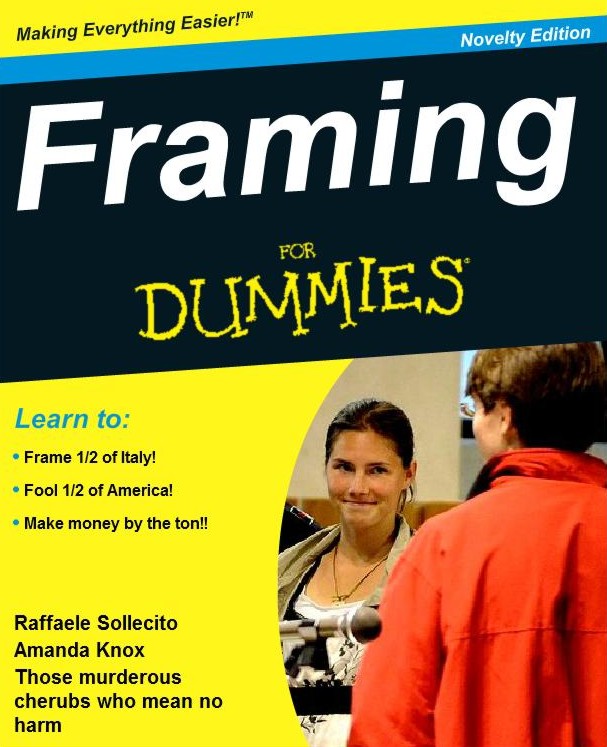
Wednesday, March 12, 2014
Council Of Magistrates In Effect Shrugs At Judge Nencini Answering Loaded Question Of A Reporter
Posted by Peter Quennell
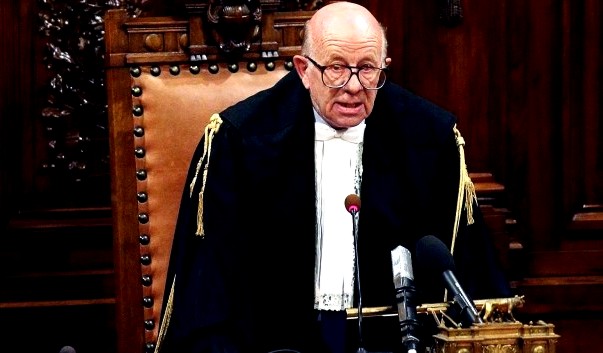
[Cassation judge Antonio Esposito who just faced down a similar complaint to the CSM]
The only ones pushing for the CSM committee hearing today and maybe another one at Cassation were Giulia Bongiorno and a few political friends.
Everybody knows she has once again lost very big and once again is snakily trying to demonize the court rather than gracefully moving on.
The final vote of the full CSM will be announced next week, but it seems a foregone conclusion. The Council will shrug and move on.
Judge Nencini explained himself well for one hour (with his wife, also a judge, present) and probably no magistrate on the Council would have acted so differently, given that the michievous reporter had been asking if the killing of Meredith happened simply because the three had nothing better to do.
Maybe some of the magistrates were thinking “So Bongiorno didnt put Sollecito on the stand? Hmmm, she KNOWS of his guilt only too well”. There is no mood among them to to see the defiant Sollecito who has slimed the system and slimed a much admired judge use a loophole to get himself off.
Jools explained the context of today’s hearing several weeks ago and translated one of the media reports for us today.
Knox, Sollecito judge unlikely to be disciplined by CSM
Inquiry over post-conviction press statements
Rome, March 11 - The Italian judiciary’s self-governing body, the CSM, is likely to drop an inquiry into a Florence judge who broke Italian legal convention by giving press interviews after convicting Amanda Knox and her ex-boyfriend Raffaele Sollecito for the 2007 murder of British student Meredith Kercher in February, judicial sources said Tuesday.
In Italy, judges usually only talk about their verdicts via written explanations published at least a month after they are handed down. But Alessandro Nencini, the head of the panel that sentenced Sollecito to 25 years and American citizen Knox to 28 and a half years at the repeat of the appeals-level trial, gave three interviews to different newspapers that were published February 1.
As a result, Nencini was accused of being biased. One of the most controversial aspects is that in one of the interviews, Nencini seemed to suggest that the fact Sollecito had not allowed himself to be cross-examined had damaged his chances of getting off.
The judge told a CSM commission Wednesday that he did not give interviews, but rather spoke in passing to reporters at the courthouse. He also denied saying the murder was the result of ‘‘kid’s play’’ gone wrong, or expressing an opinion on Sollecito’s defense strategy.
The hearing transcript will be available within a week, when the CSM commission will make its opinion official. The consensus seems to be that Nencini’s statements to the press may have been ill-timed, but not enough to justify a transfer, judicial sources said. Nencini is still not out of the woods, pending the result of justice ministry and Cassation Court inquiries that could lead to disciplinary action against him.
Friday, February 28, 2014
What We Might Read Into Sollecito Lawyer Giulia Bongiornos Final Arguments To The Appeal Judges
Posted by Machiavelli
Under the table & over the top
The picture of a serene-looking Giulia Bongiorno waving a couple of knives in court on 9 January may be visual inspiration to this reflection about what we can understand from the structure and content of her closing arguments.
A very peculiar feature of her arguments was the desperate opening, suggesting to put the investigation ““ and the whole justice proceedings ““ on trial.
The introductive topic of her speech is a quote from a book by Alessandro Satta, a narrative description of the riotous irruption of the mob inside the Revolutionary Tribunal hearing room on Sep. 2. 1792, the defendants are the some of the King’s Swiss guards.
The passage by Satta describes the “horrendous” vision of a hord of sanculots slowly gathering outside the court, Bongiorno compares that to the angry mob in Perugia after the first appeal verdict.
But if you read the same text by Satta a little further, a few lines beyond the snippet Bongiorno was reading, the narration goes on describing how sanculots manage to enter the courtroom, in a force of hundreds ready to lynch the defendants, but they are suddenly halted by an authoritative order of the Judge, and they unexpectedly obey.
Just after that, Satta drops in an explanatory quote from the book Le Tribunal révolutionnaire (by historian Lenotre) saying: “the people understood that these highly educated individuals in black robes would have gone on with the action started by the hords, and they would accomplish it more perfectly”.
It seems like Bongiorno opened her speech with an implicit depiction of the judges and magistrates of Perugia as kind of Jacobin extremists whose task is to “legitimize” the vindictive fury of a pitchforks mob.
The quote she read did not include Satta’s conclusive lines, so that the consequent thought about the judges’ role remained unexpressed and in the background.
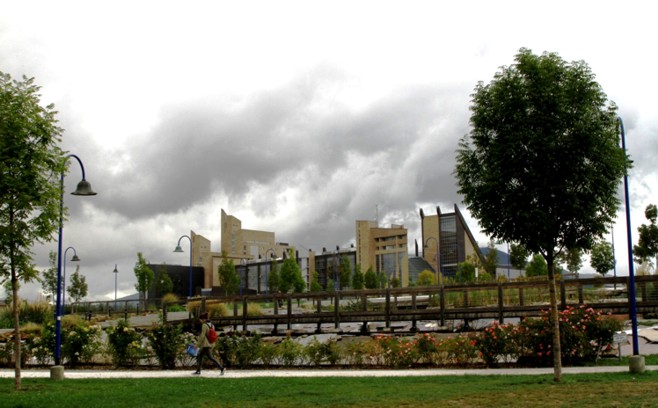
(Photo by Machiavelli_Aki)
A side note about Bongiorno’s arguments: in fact I had the feeling that allusion to implicit subtexts was something that belonged to her speech as a method or a style, it marked the whole of her arguments. You may recall Wittgenstein’s dictum “This work consists of two part, what is written in it, and what is not written in it. The latter is the most important part.”
Such a motto might be apt to address the major feature of Bongiorno’s defensive argument, insofar as she conveyed that something that “couldn’t be talked about openly” was there and that was probably a main argument.
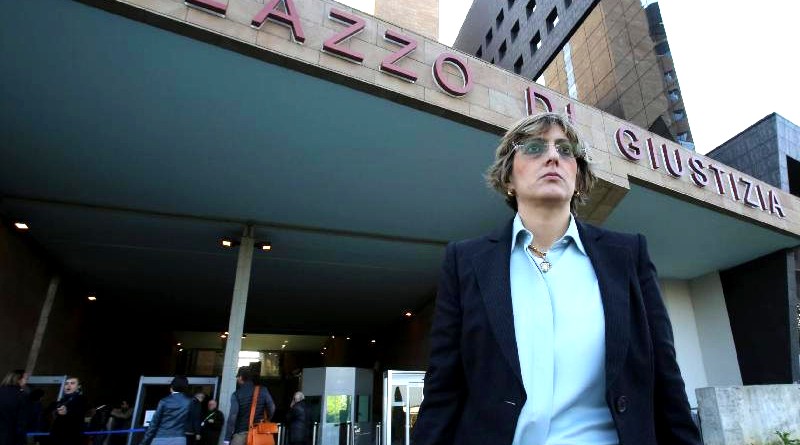
(photo by Ansa)
At first, as I said, she went through a brief emotional recollection of her moments while in Perugia surrounded by a raging mob, and then she unfolded the rest of her introductive section.
The purpose of this bit of revolutionary narrative first juxtaposing the Perugian citizens to Sanculots and the judges to Jacobins, and then, immediately following, a series of accessory arguments all encompassed by an introductive function, all this was clearly intended to set a framework thesis meant to work as a basis for the structure of the whole defensive arguments.
It is in fact a peculiar structure, apparently entirely resting upon one, single elaborate premise.
The thesis she places at the foundation of the entire defensive argumentation is the following: the trial as a whole, as much as its outcome, had been somehow determined and “tainted” from the beginning by events which occurred within a very short framework of time, in the very early days of the investigation, the weeks around the time of the suspects’ arrests.
Bongiorno suggested that only this “short period” ““ the early days of November 2007 - is what matters and the only topic worth of a defence analysis; since this was the time frame within which - according to Bongiorno - everything was decided, this was the time when some “errors” in the investigation occurred, before the point when a veil of prejudice and hatred fell upon people’s hearts and minds like kind of black curtain, preventing from that moment on any fair or rational judgement.
Aggressive Digressions
After the quoting of Satta’s speech, she develops her introduction for a while, branching out into some political-sociological speculations (such as that authorities chose the crime scenario that was most reassuring for the population) as well as some political-anthropological consideration (like the theory that free spirited women are seen as suspicious as a consequence of women empowerment movements).
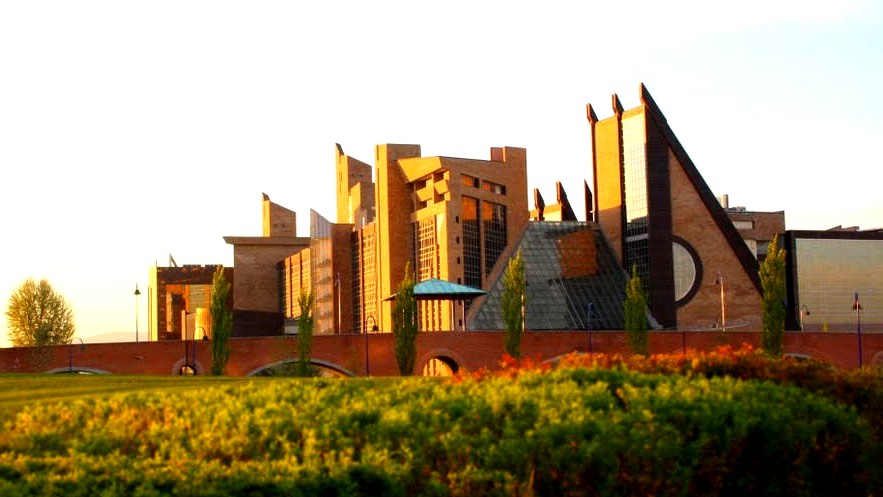
(Palace of Justice of Florence ““ photo by FrederickStudio)
A speech opening as did Bongiorno’s, that is, relying on a set of over-the-top considerations, and apparently so much depending upon one extreme premise, unavoidably conveys a perception of weakness, which is at risk to be transferred to the rest of the argumentation.
Thus, it would be a logical question to ask ourselves: why did Bongiorno chose such a setting and introduction, with several risky, over-shooting arguments?
A perception that the argument was unconvincing was palpable among the public as she was unfolding her theories about Perugian police opting for “political” scenarios and about sexy and free women seen as suspicious because of the women’s political movement.
Scepticism emerged even more openly when she described a scene with Amanda Knox releasing her false accusations while speaking under the hypnotic influence of interpreter Anna Donnino - whom she called “psychic” ““ which triggered some stifled laughs among the public.
Then her long introduction dealt with the unfolding of a rhetorical structure set around the concept of “half”.
I use the word ” rhetoric” in a most technical, non-derogatory sense, to mean the setting of a clear order and concepts designed to be easily remembered, anchored to multiple implicit suggestions, so as to remain impressed in the mind of listeners what is distinctive of the style of Giulia Bongiorno.
Introducing to “˜Halves’
In the previous trial instances she didn’t miss the opportunity to borrow characters such as Jessica Rabbit, Amelie and the Venus in a Fur. I thought she would mention at least a few characters of Disney or the Harry Potter saga this time too, and I was not disappointed as she met expectations on this matter (she did mention Harry Potter, the Eskimo kiss “˜Unca-Nunca’, the Bunga Bunga, the Aladdin Lamp and 9½ Weeks).
She entered the topical part of the introductive section saying “˜basta’ to always focusing on Amanda’s personality alone, while considering Raffaele just Knox’s other “half”, he is not half a character, he should not be seen as reflexion of Knox.
The curse of being “half” chases him also, meaning there are only “half pieces of evidence” against him. And this is the rhetoric structure envigorating the arguments after the introduction, the concept of “half” .
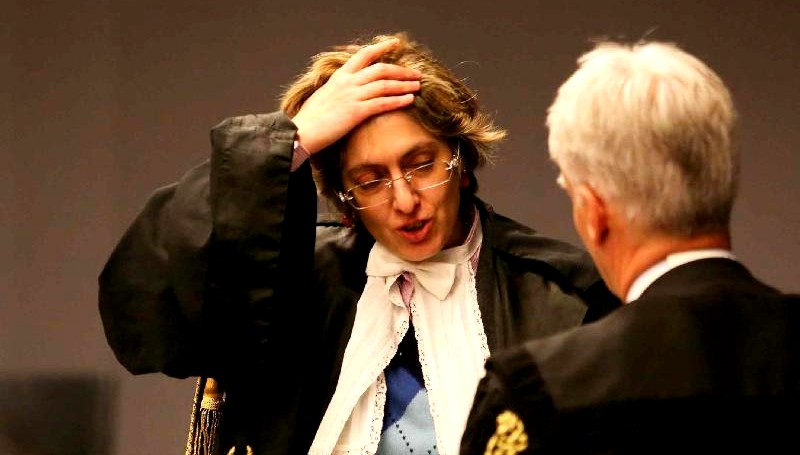
Only half pieces of evidence, almost a half admission, or the clear suggestion that there is maybe one “other half” of something (of culprits?) somewhere else, something not to be said, something that is not here.
The concept of “half” recurs and somehow pervades her defence, we should say something more about later on because she picked it up also in the subsequent hours of speech.
Some videos from the Florence trial available may still be available at the Sky site.
Primordial Fossils
Only after recollecting all these things in the “˜aggressive digressions’ over the introductive part, she goes on with a ponderous section which is the main part of her argumentation.
It’s a topic directly stemming from the introductive themes and premises, in the sense that this main part focuses on and blows up events of the first four days of investigation. It zeroes on few small details of the investigation history, the previous introductive part functionally working to justify the choice and to limit the argumentation to these topics.
Something the listener would notice from this first and main part of the arguments, as everyone well understands, is that these arguments are arranged in a peculiar type of architecture. A choice that makes crystal clear the actual state of the defence’s options.
The defence strategy is to focus attention on the supposed flaws in evidence collection at the beginning of the investigation, and not on the evidence set itself.
Bongiorno’s arguments do not map out the evidence set array. They do not devolve an effort of analysis in proportion to the actual weight of the of pieces of evidence.
The bulk of her speech in fact can be summarized as a criticism of some historical happenings ““ what she sees as such ““ which allegedly occurred within a very small time frame. She devoted hours to attacking the beginning of the investigation, early errors such as that the shoe print that had been wrongly attributed to Sollecito on a first assessment.
It appears this attack against the early procedures of the investigation was really considered to be the most effective weapon the defence had left.
The “˜topics’ Bongiorno addressed in this attack as “˜main points’ of evidence against Sollecito, are only three: the wrongly attribute shoeprint, Sollecito’s side-tracking the investigation, and “˜the knife’ (a topic which gets picked up again later, with a long discussion focused on the blade length).
In the same “˜knife’ topic she included DNA discussion, in a connected digression she dealt with the bra claps, called all the scientific evidence collection “˜the mother of mistakes’ and offered again the known criticism of Stefanoni’s alleged “suspect-centred”.
Later in her speech, she dealt with the other evidence topics, parroted the “˜principles’ expressed in the Conti & Vecchiotti report, offered the known arguments about the bathmat print, etc.
But the bulk of her defence hinged around those “˜mistakes’ in the early investigation phase, this was the actual core of her argumentation, while the other pieces of evidence were dealt with summarily, I had the impression they were almost treated as accessories.
It was clear above all that the defence was not battling the structure of the evidence actually existing today, they were battling a minuscule part of it, or better they were battling something else, something which is not directly the evidence, but rather some historical foundations of the accusation building.
Basically what Bongiorno conveyed is, the fighting terrain was the “˜investigators’ errors’, their “˜excesses’. That is, they were not actively contending Raffaele’s innocence any more.
The implicit content was rather obvious to the listener: a direct claim of Sollecito’s innocence had been already abandoned, that territory was left beyond the lines and the defensive front had been drawn back.
The topic now was not innocence, but rather how the accusation had been unfair and excessive.
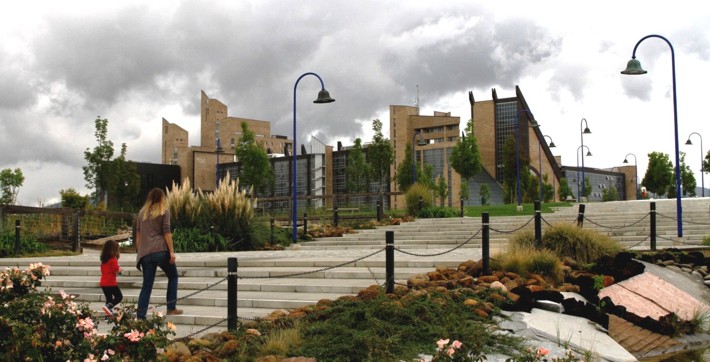
At her opening, the quote of Satta was a device to draw attention to the events at the “origin”, so as to prepare listeners for the fact that defence arguments will be focused on what happened during the moments before the “black curtain” came down.
Hence the a long introduction starting from an image of the fury of a mob of sanculots, a narrative on this theme: people were willing to convict the defendants immediately and judges were legitimizing people’s violence.
She oriented the discussion towards the topic of early prejudice and excesses, so to justify the fact that she will talk about the early phases rather than the evidence set, and then she introduced the leit-motiv of the “half”.
This means, rather than disputing the pieces of evidence, Bongiorno wanted to set a “trial of the investigation”, she zeroed on just a few details actually not having much relevance in the actual evidence set.
She talked at length about elements that are kind of fossils ““ like when she went on discussing about the number of circles in the sole of Guede’s shoeprint ““ putting the alleged “errors” in the course of the investigation on trial, and her speech at times sounded as if it was a lecture about dinosaurs, recalling curious things now extinct.
The explicit function of her introduction was to justify her setting aside the evidence set, downplaying it by framing it into a historical moment, maintaining that it was collected and interpreted when investigators were already beyond the “black curtain” of bias, therefore tainted by prejudice, while judges were like sycophants before an angry mob.
The purpose behind the Black Curtain
The implicit, most important function of the introduction was accomplished via the concept of “half” and all the subliminal suggestions attached.
We should ask ourselves: is it reasonable to believe Bongiorno was so naïve to expect that the court may accept a theory about a dismissal of evidence in limine?
The answer is no. Bongiorno knew perfectly well that her preliminary criticism of the investigation would not lead to a dismissal of the evidence.
Bongiorno also knew that the series of preliminary arguments she would offer would be considered ineffective by judges. Such as that the knife DNA should be seen as unreliable preliminarily, that Stefanoni’s work lacked “transparency”, that Vecchiotti and Conti’s “method” should be taken at face value (Bongiorno knows C&V’s intellectual honesty was called manifestly questionable by the Supreme Court ), that this and that allele in the bra clasp DNA should not be considered because, etc.
She also knows that this court will not allow pieces of evidence to be considered separately from each other in a parcelled out way, and that imperfection of single pieces themselves do not work as a logical argument. Even less could she dismiss the evidence based on political and anthropological theories.
From the fact that she was setting afoot on a trial of the investigation instead of battling the evidence, the rational listener infers that she is well aware of the weakness of her position, since it implies that the evidence set as the battleground would be indefensible. She needs to search for another terrain of attack, a different structure, as the only possible move.
But there is also another implication. She does need to engage and draw attention to areas where she could “win” something, but this also means that her intent was to “soften” the accusation, to work it out at the flanks rather than face it frontally; to reduce the size of some fundamentals, the “excess” of the accusation.
In other words, to shorten the sentence. And if possible, to separate Sollecito’s position from that of Amanda Knox, albeit within the boundaries of her client’s plea.
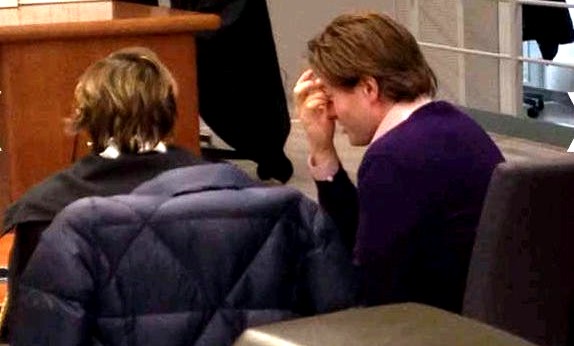
Her strategy of attack had a reason, that was to try to soften the accusatory attitude against Sollecito. Besides being risky (may sound extremely unconvincing) the strategy was also loaded with implicit meanings.
What was most stunning to me ““ as it was a recurrent topic through her whole speech ““ was the concept of “half”. She picked up this introductive theme several times, such as while speaking about the medical findings explaining that only “half” the length of the blade would be used, if a knife so large as Sollecito’s kitchen knife was used, saying that, in this event, this would mean the perpetrator did not intend to kill and killing was the effect of “mistake”, an involuntary movement.
The importance of the length of the big blade and its “half” was emphasized by a waving of knifes, in a quite impressive theatrical performance: “Either the big wound was made by a smaller knife” that was held by “someone else” or the knife was “plunged only by half” showing there was no intent to kill.
All this is to be coupled with the fact that, as said above, she devoted a main portion of her 6-hour speech to discussing things that are fossils, elements not existing any more.
She dealt later with other pieces of evidence too, though in a way that seemed somehow marginal, and she did not deal with some of them at all - the inconsistencies in Knox’s account, for example, were left completely out.
She was not that kind with Knox’s written memorials either, calling them “farneticanti” (waffling, raving).
I noted her complaining about Raffaele being “halved”, as his character is portrayed as depending on Amanda’s and thus seen as equally guilty insofar he was Amanda’s half ““ and this effect is somehow transferred to pieces of evidence.
Bongiorno’s rhetoric emphasizes that Sollecito was accused on “half” pieces of evidence (you perceive that the metaphorical repeating of “half” implies that evidence actually exists, “by half”, and at the same time this complaint about being seen as “half” of something is a subliminal suggestion that the defendants should be considered separately, and their charges as well, thus maybe their responsibilities if considered separately may be different; and when it comes to discussing how the murderer used only half of the blade, the subliminal suggestion is bring down the charge by half, involuntary event/manslaughter versus voluntary murder).
The Mark of Infamy
Giulia Bongiorno picked on the investigators and acted as if she was putting the investigation on trial not because she thought that this would lkead to the defendants being found innocent, but exactly for the opposite reason, because she expected them to be found guilty.
Insults against Prosecutor General Crini, against witnesses and and gratuitous accusations are a risky path but they are also an overt attempt to “soften” the investigation scenario, rather than fight it frontally.
She had no hope to make her client look innocent, her only hope was to soften the strength of the accusation, to make him look less guilty, not so bad as the investigators saw him.
She pursued this in two ways, by suggesting that he should not be seen as the “half” of another perp but rather his responsibility should be considered separately, only that evidence which proves directly against him (Bongiorno repeatedly pointed out that Knox did not utter his name in her interrogation and statement), his actual responsibility might be much lesser than the charge for which he is accused.
The other arm of the defence’s pincer move, the second way to try diminish the accusation, was to portray the investigators in bad light. The “˜excess’ of accusation was to lay blame on investigators for their bias and errors.
Bongiorno’s attack against the investigation might be intended to achieve a psychological effect due to comparative process.
If you consider how the police are responsible for “˜excesses’ and disputable behaviours, you may think the investigators have been prone to gross mistakes that lead to exaggerating Sollecito’s implication, thus the accusation should be not be taken at face value and should be corrected. Maybe the correct assessment of evidence proves he not as much implicated as they had thought.
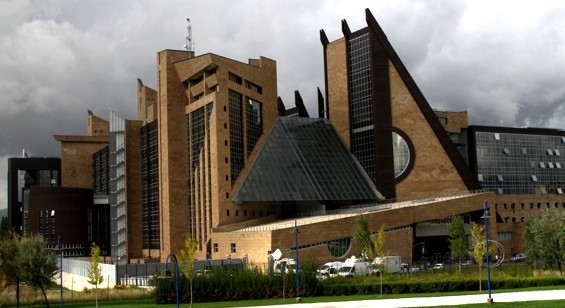
This seemed to be Sollecito’s own defence strategy, albeit implicit, since Bongiorno must restrain her action within the boundaries of her client’s plea.
In order to follow her strategy, however, Giulia Bongiorno decided to take a few steps which must be pointed out as particularly reprehensible and infamous.
I was surprised and stunned by those action because they qualify the character of Giulia Bongiorno as far worse than I thought, I really did not expect her to stoop so low.
The infamous part of Bongiorno’s speech is her gratuitous name calling and defamatory attack against Anna Donnino, her attempt to smear her professional reputation and the rude insult in calling her a “˜psychic’.
In real life Anna Donnino is a very respected professional, she has been working for the Questura on tasks of interpreter and language mediator (not as a “˜translator’).
She is also an intelligent person, she is precise and expresses herself with the utmost clarity as her lucid testimony shows.
She is known not only for having unquestionable professional ethics, but also she has an excellent reputation as a person; she is honest and humane and known by everybody for her extremely reassuring, protective temperament, and for her expertise and excellent performance of working with people.
She would help immigrants in difficulty to express themselves and understand their rights and was priceless helping the police to obtain precise information in their investigations.
As an expert in chuchotage and linguistic mediation from two foreign languages, the professional quality of her work is excellent. Her training and work is of interpreter and language mediator although sometimes shee is given translating tasks such as the translation of recordings and wiretappings.
The Questura of Perugia used to hire “˜language mediators’ at the time. You don’t know what a language mediator is? See a university course for a degree in Language Mediation.
The Questuras of some bigger cities also have “˜cultural mediators’ in addition. They are mother-tongue trained to deal with African or Chinese immigrants (one of the many young people having their internship as cultural mediator in a Questura is shown here.)
To me, this defamatory attack against Donnino was most disturbing. By doing this Bongiorno came across as surprisingly mean, I’d say what she did was really infamous.
Indeed this was not the only virulent attack, it came after insults to the city of Perugia as she was comparing its citizens to a mob of blood-thirsty fanatics.
This attack too is also particularly vicious, since it exploits, inflames and is subtly synergic with the tones of lies and prejudices disseminated by a perfidious propaganda strategy.
But at a certain point, Bongiorno focused the defamation against one person. As she unfolded a narrative about Anna Donnino acting as a “˜psychic’ who managed to hypnotize, to gaslight Knox to the point of inducing a state of trance in which she mistook a dream for reality, some people couldn’t help laughing in the courtroom.
But even if we consider the surreal and comical rather than the convincing effect, the defamatory intent stands out as reprehensible and humanly vicious.
This is because, as I said above, these particular insults were directed against a person distinguishable for her being a most decent, honest and trustworthy character, and also ““ a further reason ““ because of the recent events for which this person experienced personal suffering: Anna Donnino, a mother of teenagers, has been struck with cancer, and has undergone surgery.
She is under treatment but still currently remains in very bad health.
The attack against Anna Donnino is an action that rebounds as an ugly stain on the reputation of those who launched it. A young man from Perugia created a Facebook group to express a the citizens’ “hate” for those who lead a defamatory campaign of lies against the city. He collected over two thousand likes within three days.
Some of the comments were about Bongiorno’s insults against the city and against respected citizens, pointing out her outrageous hypocrisy since Giulia Bongiorno poses as a campaigner for the respect and dignity of women.
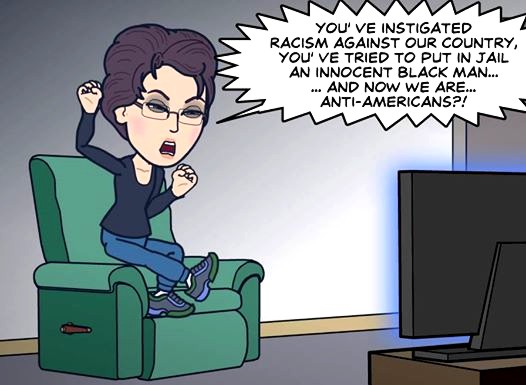
(a StripBit comment by a poster on a Facebook group)
Criticism of Giulia Bongriorno pointing out her hypocrisy is actually not a novelty, it has appeared long since in the press and on the internet.
But it’s hard to understand how someone like her, promoting an image of herself as an advocate for women and for correctness and respect in language and culture, could take such a an egregiously visible false step, come out with such stupid stereotypical rants, only for what looks like an awkward and useless cause.
Conclusion
A note for the record: we may recall Bongiorno has also attacked the Perugian police officers, citing the recording of some of their phone conversations in which they say bad words about the Sollecito family.
We can understand her outrage (at least we could, if only she were not the hypocrite she is) but at the same time we can’t fail to notice that she “forgot” to mention another half of the phone call recordings.
Specifically those where the members of the Sollecito family were speaking about the police officers; and the kind of language they were using, while attempting to plot “˜under the table’ help from some politician.
Expressing their intent to “˜scorch’ officers and “˜destroy’ magistrates, and one person even suggested that if he met Monica Napoleoni on the road, he would kill her by “˜running over her with the car’ then flee without telling anything, pretending that nothing happened.
Never mind.
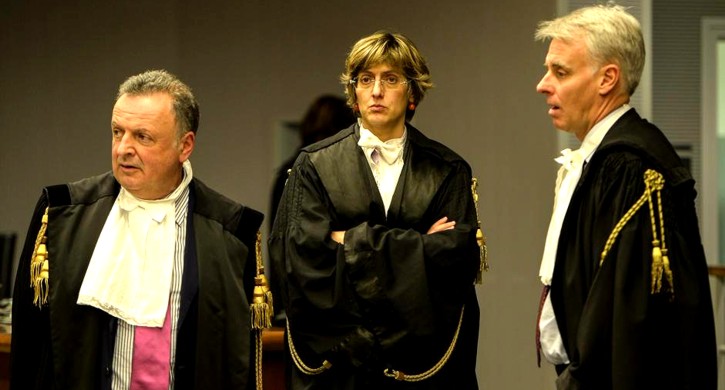
After these last sparkles and the knife waving Bongiorno’s performance was over. In the following day’s hearing it was Maori’s turn. As a really last resort, he was taking on the task of disputing evidence in a more “traditional” way, objecting to points of evidence.
Possibly this revealed even more the extreme weakness of the defensive argument (a commenter called it “˜pathetic’). I did not listen to his argument myself, I only notice that he did not get much space neither in the press nor in the pro-Knox commenting sites; this might be a clue of how unconvincing he might have been.
One thing that however I could learn about it, is about the feeling, the perception that Maori pointed out even more the separation between the two positions of Amanda Knox and Raffaele Sollecito.
A hint about this comes in the words of a journalist who was questioning Alessandro Nencini in the lounge immediately after the verdict: the journalist pointed out how Sollecito defence “tried to split the positions of the two accused”.
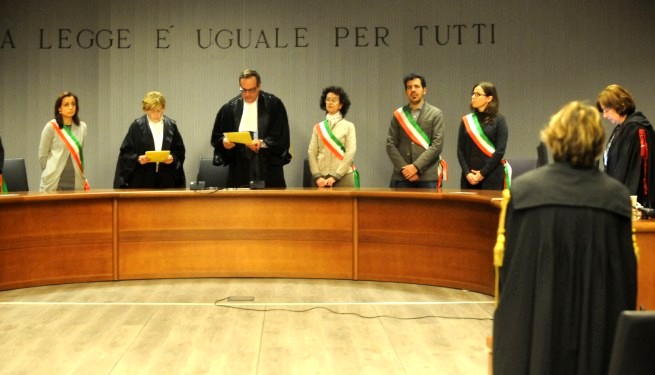
This mild attempt of a separation was the last act by the defence. As for Raffaele Sollecito himself, we were left with his rather different claim, his book where he described himself as sticking to a “˜honour bound’.
He reportedly bragged about this also with his ex-girlfriend Kelsey Kay, who described him as feeling very entitled because of his loyalty to Amanda Knox and believing she owes him a vital a favour; but Knox won’t even respond to his messages.
Then, we had his final admission in an interview that his friendship with Amanda Knox has “˜deteriorated’, because apparently Knox in practice no longer supports him as before.
If his defence advisors understood that they needed to somehow “˜separate’ his position from Knox’s at any cost, despite his plea, to suggest he may be implicated but just “˜less’ guilty, we may only agree with them on this. It would also be convenient for him to confess even if he shared the same degree of guilt of Knox.
Sadly, instead he still felt compelled to offer further lies and changing stories such as”˜I noticed no blood on the bathmat’ when questioned by Kate Couric; he offered again a story of pricking Meredith’s hand while cooking together at the cottage.
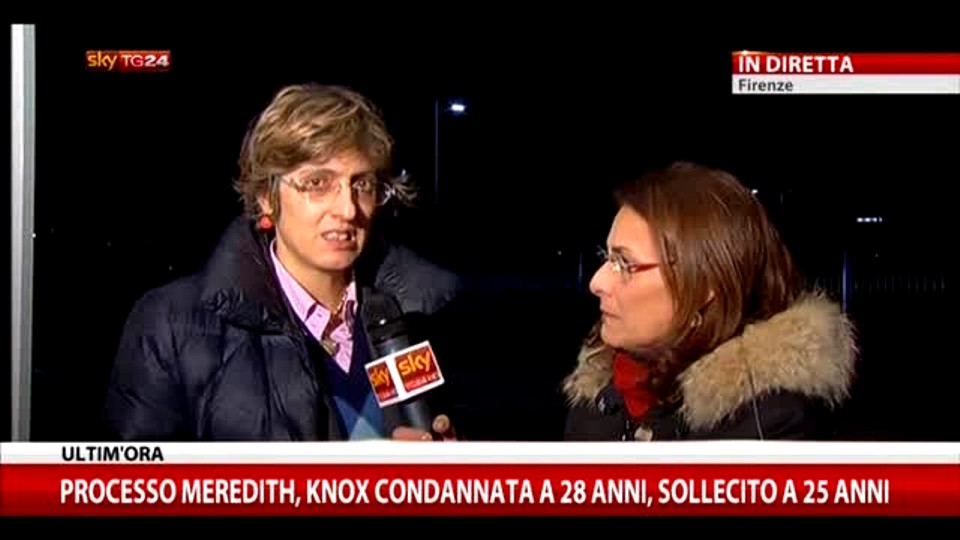
Other murderers, who committed even more heinous crimes, have recovered and rehabilitated themselves after time spent in prison; even some of those deemed among the worst serial killers managed to do this by expressing remorse ““ for example the rather psychopathic “˜Ludwig’ (Furlan & Abel) killers.
Sure after the years he will spend in jail for the gang-like crime he is found guilty of, there would be a possibility for a “˜casual murderer’ such as he is to be perceived as rehabilitated. But to see him as “˜less guilty’ or as “˜rehabilitated’ would be impossible as long as he remains silent or denies.
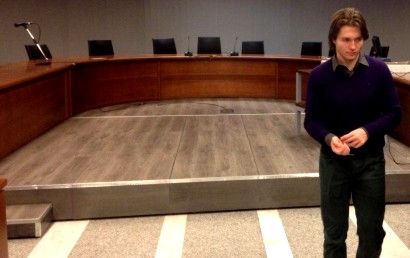

Wednesday, February 26, 2014
How Claims By Perpetrators & Their PR That THEY Are Victims Get Equal Pushback
Posted by Peter Quennell
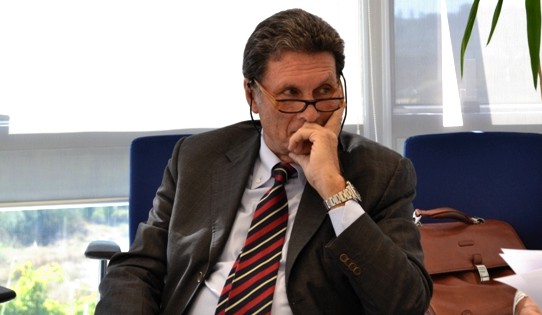
[Florence prosecutor Giambartolomei will soon confront many false claims ]
To the considerable pain of victims and their loved ones, Italy’s has become one of the most pro-defendant justice and penal systems in the world.
That doesn’t mean that it has become a complete pussycat. Push it, and it usually pushes back harder in its search for the truth. And the quality Italian media goes along.
Time and again the ill-conceived short-term PR and legal tactics for Knox and Sollecito based on a hurricane of lies have left them in terms of the ultimate end-game worse off than they were before.
Judge Matteini and Judge Micheli (the judges in 2008) both took firm lines with the copious evidence and the psychological tests of AK and RS in front of them.
Both judges took a line as firm as the prosecution (as firm as the “evil Mignini”) in concluding that there was a drug-fueled hazing escalating to murder with sexual aspects (however short the timescale of the intent).
[Ed note: See comment by Yummi below which explains the above a little differently. PQ.]
Though his panel of judges voted unanimously for guilt, Judge Massei in 2009 did take a somewhat less firm line in the sentences, after observing one daffy defendant and one very nervous defendant sitting in front of him for nearly a year. Judge Massei for no especially convincing reason
(1) pinned the initiating of the attack on Rudy Guede (really?!) and
(2) handed Knox and Sollecito (and thus Guede) quite a break with his supposed “mitigating circumstances” (the duvet over Meredith’s body) resulting in 20 years lopped off their combined sentences.
Both the defenses and the PR were weak and largely futile in that year. But come 2010 the dirty tricks moved into overdrive.
Cassation reverted to the firmer line in January 2011 when it ruled on Guede’s final appeal: Guede was a party to the murder, but copious evidence proved he did not act alone.
The Hellmann appeal court and DNA consultancy and verdict of 2011 were corrupted (counter-measures are still quietly playing out) which fully explains its startling soft line.
Thereafter the Italian courts observed the illegal blood-money binge with the essentially fictional books of Sollecito and Knox, and two years of them each claiming to ill-prepared interviewers “we’re the real victims” on TV.
Cassation observed all of this, annulled the corrupted Hellmann court verdict, and issued instructions in June 2013 to the Florence appeal court to ensure that the firm line should be maintained. Unsurprisingly, we have seen a firm line from the chief prosecutor (Crini) and a seeming firm line from the lead judge (Nencini) in recent weeks.
In the rest of this year Italy will see at minimum these events where the court’s firm line will go on and the babbling and unhelpful legal and PR tactics may finally dry up.
- 1) RS and AK continuing to babble for a while on TV as they each dig the other one deeper. Sollecito has just said that his saliva or sneezing may explain why his DNA was on the clasp of the bra.
2) The sentencing report of Judge Nencini is due at the latest on 30 April and he seems likely to give space to rebuttals of any bizarre new claims made by Knox and Sollecito before 30 April like the one just above.
3) The obstruction of justice trials of witness Luciano Aviello and incessant meddlers Mario Spezi and Frank Sforza will continue, probably though into 2015. Each of those trials could result in others (like Spezi ally Doug Preston and Sforza allies Bruce Fischer and Steve Moore) being declared at minimum persons of interest if not actually charged.
4) Florence prosecutor Giambartolomei Firenze (image above) may soon be announcing which passages in Sollecito’s book Honor Bound criminally defame Italian officials or deliberately miscontrue hard facts in evidence in an illegal attempt to to poison public opinion against the court.
5) Similarly soon after on Amanda Knox’s book with the surreal title Waiting To Be Heard (and on Knox articles and interviews in Oggi) by the chief prosecutor in Bergamo.
6) Cassation’s First Chambers should be the one to handle Knox’s and Sollecito’s final appeal. They handle murder cases and they issued the guidance to Florence in 2010.
7) If so, they should take note of such revelations by way of Judge Nencini’s and Prosecutor Crini’s reports; and this next autumn or winter may finally declare a firm “confirmed guilty” final-appeal outcome and invite Knox to come back.
And when prosecutor Giambartolomei Firenze announces which claims are radiocative, hopefully a major hush will come over Heavey, Fischer, Bremner and Moore.

